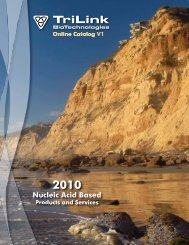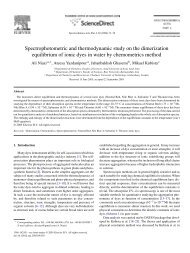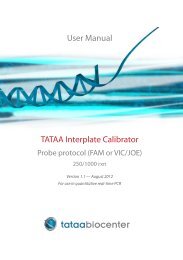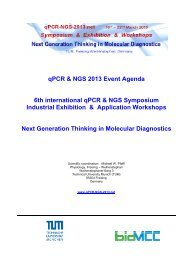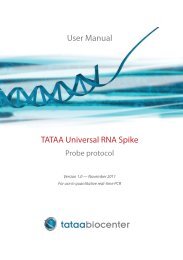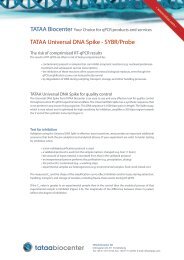ValidPrime⢠- TATAA Biocenter
ValidPrime⢠- TATAA Biocenter
ValidPrime⢠- TATAA Biocenter
You also want an ePaper? Increase the reach of your titles
YUMPU automatically turns print PDFs into web optimized ePapers that Google loves.
ValidPrimeTable of contentsBackground 4Traditional approach based on RT(-) controls 6ValidPrime 7Contents 8Storage 9Additionally required materialsand devices 9Amplification protocol 10Pipetting protocol 10GenEx 11Troubleshooting 12References 13Reorder information 13Contact 13License information 13Other products from <strong>TATAA</strong> 14(HL)-dsDNaseGenEx softwareReference Gene Panel - Human or MouseVisiBlue qPCR mix colorantCelluLyser - for rapid and easy lysis and cDNA synthesis<strong>TATAA</strong> Interplate Calibrator - Variation Compensation3
BackgroundThe ValidPrime universal assay for vertebrates is designed in one of the nontranscribedultraconserved regions (UCR) in genome. These UCRs elementsshow much higher stability during evolution than other regions of gDNA(Bejerano at al. 2004). Therefore UCRs are highly conserved and the same setof primers can be used for the most frequently studied organisms from thevertebrate family. There is 100% homology of the universal assay with followingorganisms:Chimpanzee Marmoset PlatypusCow Mouse RabbitDog Nomascus RatElephant Opossum RhesusGuinea pig Orangutan SheepHorse Panda TurkeyHuman Pig Xenopus TropicalisFor accurate gene expression analysis the measured C qshall reflect the amountof gene transcript present in the sample. This requires that the assay is specificand selective for the targeted cDNA and contributions to the signal from primerdimers, pseudogenes and genomic DNA are negligible. To test for primer dimerformation qPCR is performed in absence of template (no template control, NTC)and to test for genomic DNA (gDNA) background reverse transcription (RT) isperformed in the absence of reverse transcriptase (RT(-)). The NTC is sampleindependent and is performed only once to validate assay performance, whilethe amount of gDNA may vary and RT(-) controls are typically measured on allsamples. These controls add substantially to the cost of a qPCR study.ValidPrime is an assay to test for the presence of gDNA in test samples andwhen combined with a gDNA control sample, replaces all RT(-) controls.ValidPrime is highly optimized and specific to a non-transcribed locus of gDNAthat is present in exactly one copy per haploid normal genome. Therefore,ValidPrime measures the number of genomic copies present in a sample andcan be used for normalization of samples to cell copy number, as endogenouscontrol for CNV applications, and as control for gDNA background in RTqPCR.In rat, mouse and human the sequence has been tested and proved to have notranscriptional activity and is not present in pure cDNA preparations.4
ValidPrimeThe ValidPrime Vertebrate kit may contain a gDNA standard that can be usedto test the sensitivity of RTqPCR assays for gDNA background. <strong>TATAA</strong> <strong>Biocenter</strong>can provide gDNA reference standard for rat, mouse or human (kits ValidPrimeVertebrate with gDNA). Unfortunately our gDNA library does not span all organismsthe universal assay can be used for. If the organism you study is outof our offer, more of commercial gDNA standards can be obtained from othervendors (Biochain, Merck) or the gDNA reference standard can be prepared inyour laboratory. Assuming the material you use for isolation is not aneuploidic.In an expression profiling experiment the ValidPrime assay is added to thelist of assays and the gDNA control is added to the list of samples. From thecombined measurements with the ValidPrime assay and the gene of interest(GOI) assays on all samples and on the gDNA control the genomic backgroundcontribution to all RTqPCR measurements can be assessed. ValidPrime replacesthe need to perform RT(-) controls for all reactions and makes RTqPCR profilingeasier and substantially cheaper. In an expression profiling experiment basedon m samples and n assays, traditional set up requires m RT(-) reactions plusm x n qPCR controls, while using ValidPrime only m + n + 1 controls areneeded (Table 1).Samples (m)No. ofcontrolsAssays (n)1 10 24 48 961 2 3 11 12 25 26 49 50 97 9810 20 12 110 21 250 35 490 59 970 10724 48 26 264 35 600 49 1176 73 2328 12148 96 50 528 59 1200 73 2352 97 4656 14596 192 98 1056 107 2400 121 4704 145 9312 193Traditional RT(-) strategyValidPrimeTable 1: Total number of RT and qPCR controls needed to check for gDNAbackground using traditional RT(-) approach and ValidPrime. In an expressionprofiling experiment based on m samples and n assays, traditional set uprequires m RT(-) reactions plus m x n qPCR controls, while using ValidPrimeonly m + n + 1 controls are needed.5
ValidPrimeValidPrimeUsing ValidPrime the same test for gDNA contamination can be performedand, if needed, the same correction for background can be made, with a muchsmaller number of reactions. The sensitivities of the GOI qPCR assays for gDNAGOIValidPrime( Cq ) are tested relative to the ValidPrime assay ( Cq ) on thegDNAgDNAprovided gDNA standard. Well performing GOI assays that have been properlydesigned to exclusively target mRNA by, for example, having intron spanningprimers shall not amplify the gDNA standard, while GOI assays that amplifysequences present in multiple copies in the gDNA will have even lower C qvalues than the ValidPrime assay. All samples are then analyzed also with theValidPrimeValidPrime assay ( Cq ). The measurement setup is shown in Table 2.SampleOriginaldataGOI 1 GOI 2 GOI 3 GOI 4 ValidPrimeSample 1 20.1 31.1 22.1 28.2 32.5Sample 2 20.5 31.2 22.5 28.9 33.2Sample 3 21.0 31.1 22.9 30.2 32.3Sample 4 23.1 31.8 22.5 32.3 34.2Sample 5 23.5 30.8 22.8 32.0 33.1gDNA standard 25.8 26.9 26.7 26.0 27.0Table 2: Experimental setup based on five samples assayed for four GOI’sand ValidPrime including also the gDNA standard.GOIGOIValidPrimeValidPrimeCq is shown in black, Cq in blue, in red, CqRT(+)CqgDNASamplegDNAin orange.ValidPrimeValidPrimeFrom the measured Cq , Cq and Cq expected C qfor RT(-)SamplegDNAgDNAGOIcontrols, Cq , are calculated with Equation 2 and as before, Equation 1 is usedRT(-)to correct for the gDNA background (Table 3).GOICqGOIRT (−)= CqGOIgDNA+ValidPrime ValidPrime( Cq − Cq )SamplegDNAEquation 27
ValidPrimeGOICq RT(+)Gene 1 Gene 2 Gene 3 Gene 4GOICq RT(-)GOICq RNAGOICq RT(+)GOICq RT(-)GOICq RNAGOICq RT(+)GOICq RT(-)GOICq RNAGOICq RT(+)GOICq RT(-)GOICq RNASample 1 20.1 31.3 20.10 31.1 32.4 31.85 22.1 32.2 22.10 28.2 31.5 28.35Sample 2 20.5 32.0 20.50 31.2 33.1 31.65 22.5 32.9 22.50 28.9 32.2 29.05Sample 3 21.0 31.1 21.00 31.1 32.2 32.01 22.9 32.0 22.90 30.2 31.3 31.11Sample 4 23.1 33.0 23.10 31.8 34.1 32.13 22.5 33.9 22.50 32.3 33.2 33.41Sample 5 23.5 31.9 23.50 30.8 33.0 31.15 22.8 32.8 22.80 32.0 32.1 35.90GOITable 3: Measured Cq calculated Cq using Equation 2, andGOIRT(+)RT(-)calculated Cq using Equation 1.ContentsRNAGOI• A 6 months complimentary license for GenEx Enterprise - the easiest way tocorrect RTqPCR data for gDNA background. GenEx is the market leading softwarefor qPCR experimental design and data processing. Read more on page 11.1 GenEx license per customer, for first time users only.• For kits ValidPrime Vertebrate with gDNA gDNA for rat, mouse or human isprovided (see page 5):Reference standard gDNA 50 µl or 100 µl, c=200 ng/µl.We recommend using not more than 10 ng per qPCR.• ValidPrime universal assay primers for:250 rxns* (250 µl of primer mix, C=10 µM per primer)or 1000 rxns* (1000 µl of primer mix, C=10 µM per primer)• ValidPrime universal assay probe for:250 rxns* (125 µl of solution, C=10 µM)or 1000 rxns* (500 µl of solution, C=10 µM)* rxns = qPCR in 25 µl, concentration = 400 nM per primer, 200 nM probeThe ValidPrime assay amplifies a gDNA sequence that is present in exactlyone copy per haploid genome in a normal cell. In rat, mouse and human thesequence has been tested and proved to have no transcriptional activity and isnot present in pure cDNA preparations.The assay has very high PCR efficiency (E > 90% in tested commercial mastermixes) and produces negligible amount of primer dimer products. Limit of de-8
ValidPrimetection (LOD) is estimated to 4 copies of DNA (0.01 ng of DNA), limit of quantification(LOQ) is estimated to 32 copies of DNA (0.08 ng of DNA). Probe is usingFAM reporter and BHQ1 quencher.StorageThe ValidPrime kit can be stored for 1 month at +4 o C. For long term storage-20 o C is recommended. Repeated freeze-thaw cycles should be avoided. Vortexthoroughly and spin down before use.Additionally required materials and devices• qPCR instrumentationThe ValidPrime kit has been validated on:Roche LightCycler 480, Biorad CFX, Stratagene MxPro, Rotorgene, ABI 7500Fast and is expected to perform excellent on related instruments. The ValidPrimeprobe signal shall be measured on the instrument’s FAM channel.• Mastermix or mastermix componentsThe ValidPrime Universal vertebrate probe assay has been tested and validatedusing the conditions recommended by the manufacturer:Master mixFinalconcentrations*KAPA PROBE FAST qPCR Kit 400 nM primer, 200 nM probe ≈ 60°C* Concentration per primer and probe in qPCRAnnealingtemperatureTable 4: Recommended primer and probe concentrations, and annealingtemperature.• Pipettes and tips (available from www.tataa.com)• Vortex and centrifuge• Sample RNA/DNA• Optionally DNaseGOIWith ValidPrime measured Cq can be corrected for up to 50% gDNA background.If gDNA background is high it is recommended to reduce it byRT(+)treating9
the cDNA with double strand specific DNase that will remove specifically thegDNA and will not degrade the cDNA. We recommend heat labile dsDNase(HL-dsDNase), which is efficiently heat inactivated and does not digest the PCRproduct either. HL-dsDNase is available from www.tataa.com.• Optionally reference cDNANewly designed assays can be validated on cDNA libraries. Several cDNA librariesare available from www.tataa.com.Amplification protocolUse the recommended amplification protocol for your master mix. Optimalannealing temperature of the ValidPrime assay is about 60°C in most mastermixes, see table 4 for the optimum conditions in selected master mixes. Either2- or 3-step amplification protocol can be used.Pipetting protocolPrepare a master mix for each assay using the protocol from the manufacturer,including the recommended concentrations of primers and probe . Preparefor at least one extra reaction so you do not run out of master mix during thepipetting. An NTC is recommended to test for contamination of reagents. Werecommend 10 ng of gDNA per 10 μl qPCR, which on most qPCR instrumentsshould produce a C qfor the ValidPrime assay in the range 25-30 cycles.10
ValidPrimeGenExEasiest is to use GenEx for correction of RTqPCR data for gDNA background andfor general qPCR data processing. GenEx is market leading software for qPCRexperimental design and data processing, and is supported by all leading qPCRinstrument manufacturers. It offers user friendly optimized workflow for qPCRdata pre-processing and analysis. Pre-processing includes interplate calibration,efficiency correction, various normalization options, handling of technicalreplicates and missing data, normalization with paired samples and correctionfor gDNA contamination using ValidPrime. Analyses include absolute quantification,relative quantification and expression profiling. Tutorials are availableon: www.multid.se/tutorials.php and free support is offered on www.qpcrforum.com.A 6 months complimentary license for GenEx Enterprise is included for first timeusers with the ValidPrime kit. To get started, send an email to info@multid.seand state your order number for your ValidPrime kit together with your customerdetails. You will receive a key to activate your free license that can bedownloaded from www.multid.se. To purchase additional GenEx licenses or forqPCR data analysis services, contact us on order@tataa.com.11
Troubleshooting• I do not get any amplification/signal?The instrument may not have been programmed correctly or there may be aproblem with the master mix. Establish if the problem is in the detection orthe amplification by running the samples on a gel. Run a new test using thecommercial gDNA control (provided with ValidPrime Universal assay for rat,mouse or human).• My negative controls are amplified?Your reagents are probably contaminated.• My samples have same/higher C q-value than my NTC?You have used too little cDNA. Add more cDNA and try again. The cDNA mayalso be of poor quality. Check the quality of the RNA before performing cDNAsynthesis.• My replicates are not tight?With good quality cDNA and good pipetting technique, very high reproducibilityis expected. Low amounts of cDNA can lead to higher variation. Also, lowquality cDNA can lead to differences between replicates. Check the accuracyand reproducibility of your pipettes. It is also possible the qPCR instrument ismalperforming.• I get positive ValidPrime signal even after DNAse treatment?Often DNAse treatment does not remove all DNA and qPCR will amplify a singlemolecule. Usually solution based DNase treatment is more efficient thancolumn based DNase treatment. You may also try the HL-dsDNase from <strong>TATAA</strong>(www.tataa.com), which has superior performance to competing dsDNases.Usually DNase treatment reduces the gDNA background enough to be accountedfor by ValidPrime and GenEx correction.12
ValidPrimeReferencesHenrik Laurell, Jason Iacovoni, David Svec, Anne Abot, Jean-José Maoret,Jean-François Arnal, Mikael Kubista. Correcting RTqPCR data for genomic DNAbackground. Nucleic Acids Res. 2012.Mikael Kubista, Vendula Rusnakova, David Svec, Björn Sjögreen and AlesTichopad. GenEx - Data Analysis Software. In qPCR in Applied Microbiology.Editor: Martin Filion. Horizon Press, 2012.Gill Bejerano, Michael Pheasant, Igor Makunin, Stuart Stephen, W. JamesKent, John S. Mattick, David Haussler. Ultraconserved Elements in the HumanGenome. Science, 2004.Reorder informationThe ValidPrime kit can be ordered from <strong>TATAA</strong> by mail at order@tataa.com,from our <strong>TATAA</strong> webshop on www.tataa.com or from the local <strong>TATAA</strong> distributorin your country.ContactFor more information about ValidPrime, contact us at info@tataa.com.License informationPCR is covered by several patents owned by Hoffman-La Roche Inc., and Hoffman-LaRoche, Ltd.Purchase of the ValidPrimeTM kit does not include or provide a license with respect to any PCR relatedpatents owned by Hoffman-La Roche or others. <strong>TATAA</strong> <strong>Biocenter</strong> does not encourage or support theunauthorised or unlicensed use of the PCR process.13
Express yourgenius<strong>TATAA</strong> <strong>Biocenter</strong>, with offices inGothenburg, San Francisco andPrague is the leading provider ofreal-time PCR services and the primeorganizer of real-time PCR workshopsglobally. <strong>TATAA</strong> <strong>Biocenter</strong> conductscommissioned research andtraining within the field of moleculardiagnostics and gene expressionanalysis, along with developing realtimePCR expression panels. <strong>TATAA</strong><strong>Biocenter</strong> has great experience andexpertise in high resolution geneexpression profiling, pathogen detection,and small sample/single cellanalysis.<strong>TATAA</strong> <strong>Biocenter</strong> ABOdinsgatan 28, 411 03 GöteborgTel: +46 31 761 57 00, Fax: +46 31 15 28 90E-mail: info@tataa.com, Website: www.tataa.com





